Journal of Southern Medical University ›› 2025, Vol. 45 ›› Issue (2): 261-268.doi: 10.12122/j.issn.1673-4254.2025.02.07
Previous Articles Next Articles
Ju HUANG1,2( ), Lixia YIN3, Minzhu NIU5, Zhijun GENG1,2, Lugen ZUO2,4, Jing LI2,3, Jianguo HU2,3(
), Lixia YIN3, Minzhu NIU5, Zhijun GENG1,2, Lugen ZUO2,4, Jing LI2,3, Jianguo HU2,3( )
)
Received:2024-09-09
Online:2025-02-20
Published:2025-03-03
Contact:
Jianguo HU
E-mail:huangju0713@163.com;jghu9200@bbmc.edu.cn
Supported by:Ju HUANG, Lixia YIN, Minzhu NIU, Zhijun GENG, Lugen ZUO, Jing LI, Jianguo HU. Nodakenin ameliorates TNBS-induced experimental colitis in mice by inhibiting pyroptosis of intestinal epithelial cells[J]. Journal of Southern Medical University, 2025, 45(2): 261-268.
Add to citation manager EndNote|Ris|BibTeX
URL: https://www.j-smu.com/EN/10.12122/j.issn.1673-4254.2025.02.07
| Gene | Forward primer (5'→3') | Reverse primer (5'→3') |
|---|---|---|
| IL-1β | ACAGCAAGGCGAAAAAGGATG | TGGTGGACCACTCGGATGA |
| IL-18 | GACTCTTGCGTCAACTTCAAGG | CAGGCTGTCTTTTGTCAACGA |
| GAPDH | TGACCTCAACTACATGGTCTACA | CTTCCCATTCTCGGCCTTG |
Tab.1 Primer sequences for qRT-PCR
| Gene | Forward primer (5'→3') | Reverse primer (5'→3') |
|---|---|---|
| IL-1β | ACAGCAAGGCGAAAAAGGATG | TGGTGGACCACTCGGATGA |
| IL-18 | GACTCTTGCGTCAACTTCAAGG | CAGGCTGTCTTTTGTCAACGA |
| GAPDH | TGACCTCAACTACATGGTCTACA | CTTCCCATTCTCGGCCTTG |
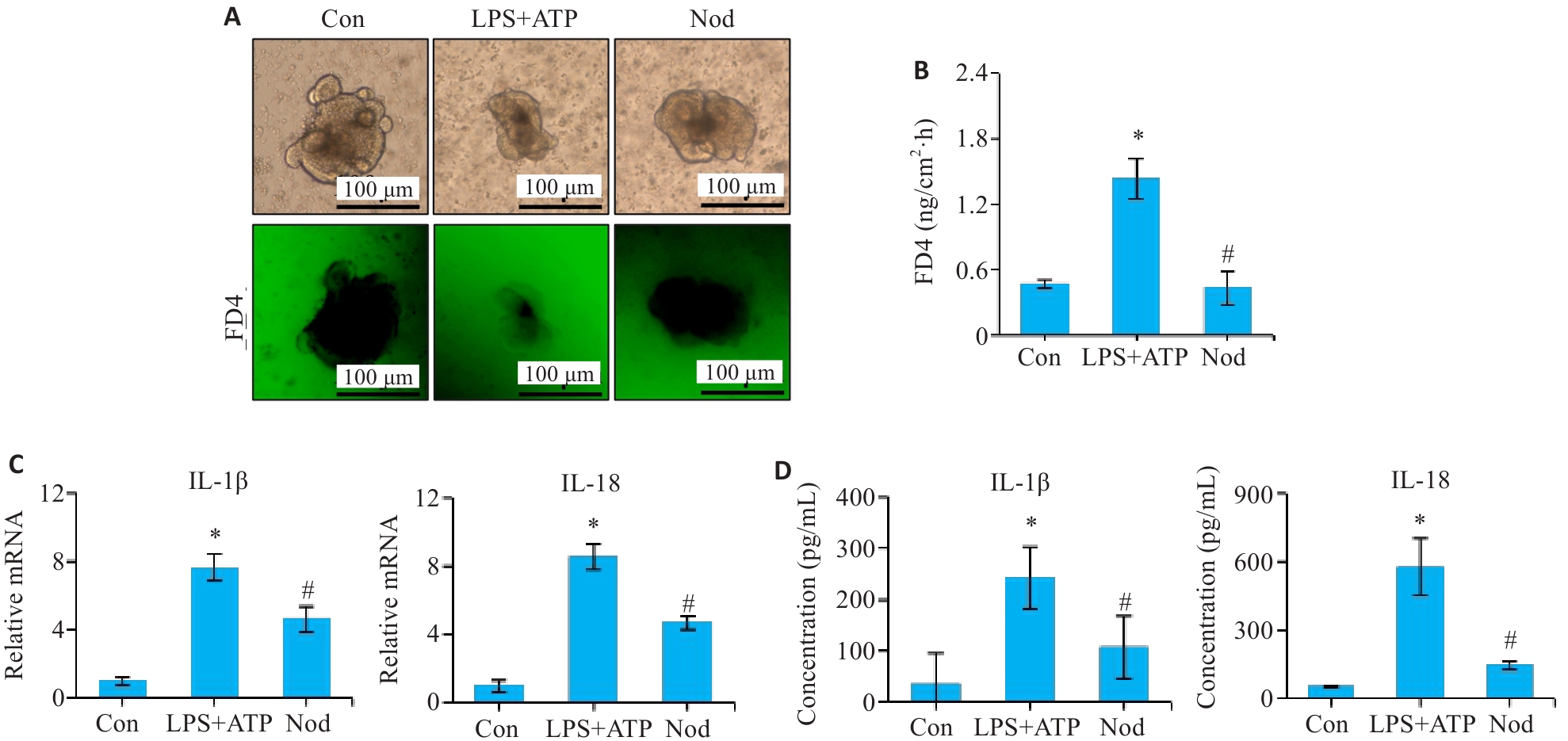
Fig.2 Effect of Nod on permeability and pro-inflammatory factor expression in colonic organoids. A, B: Permeability assay of the colonic organoids. C: qRT-PCR analysis of mRNA levels of IL-1β and IL-18 in the colonic organoids. D: ELISA of protein levels of IL-1β and IL-18 in culture supernatants of the colonic organoids.*P<0.05 vs Con group; #P<0.05 vs LPS+ATP group.
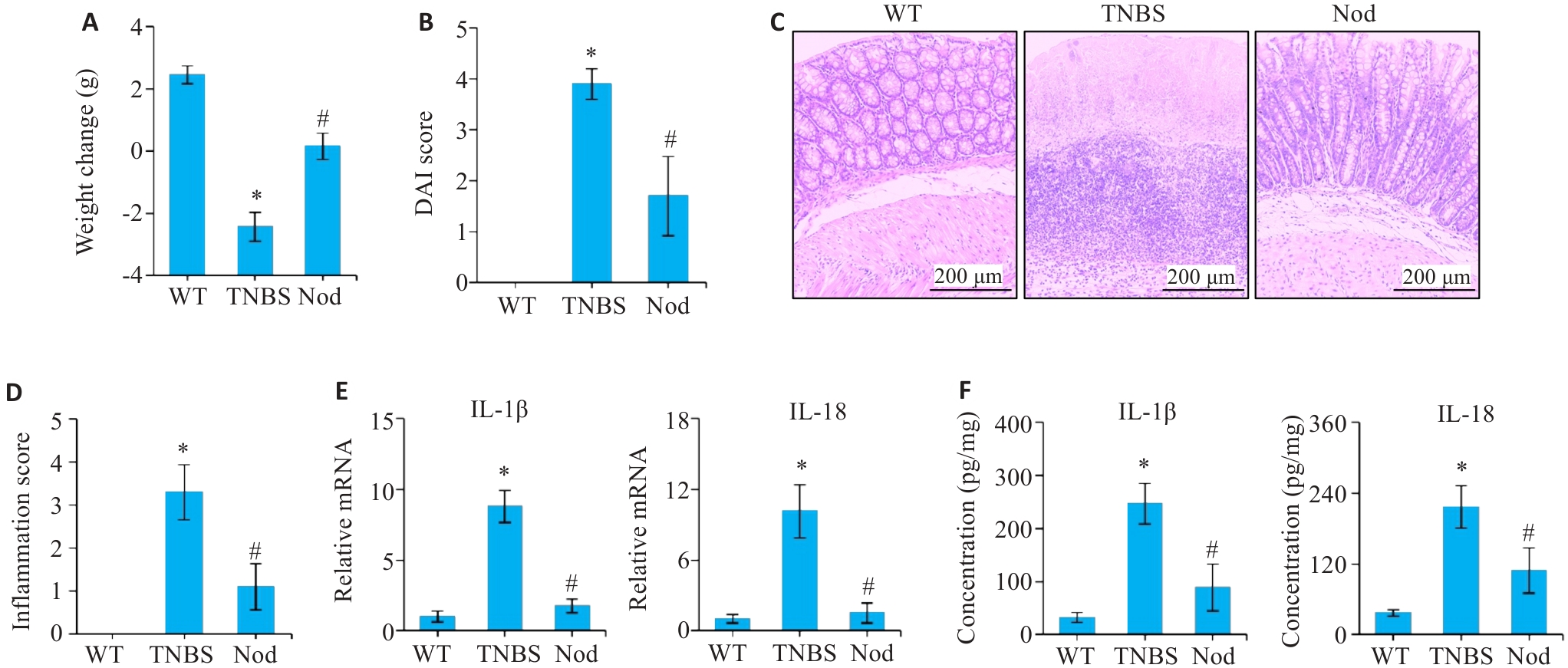
Fig.3 Effect of Nod on TNBS-induced colitis in mice. A: Weight change of the mice. B: DAI score. C: HE staining of the colon tissue. D: Inflammation score of the colon tissue. E: mRNA expression levels of IL-1β and IL-18 analyzed using qRT-PCR. F: Protein expression levels of IL-1β and IL-18 detected by ELISA.*P<0.05 vs WT group; #P<0.05 vs TNBS group.
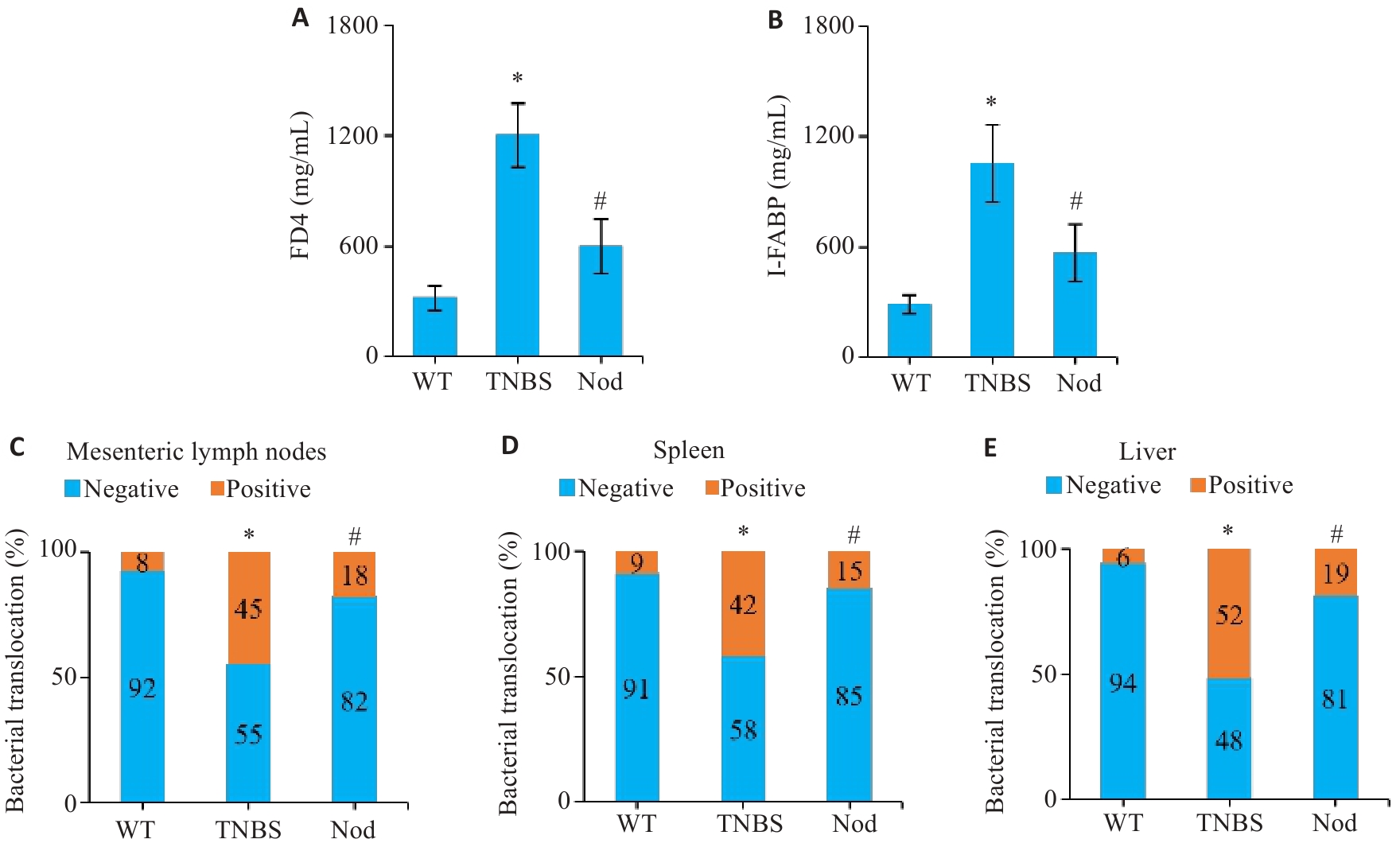
Fig.4 Effect of Nod on intestinal barrier in TNBS-treated mice. A, B: Detection of serum FD4 and I-FABP levels in the mice. C-E: Positive rate of translocation of intestinal bacteria to the mesenteric lymph nodes, spleen, and liver. *P<0.05 vs WT group; #P<0.05 vs TNBS group.
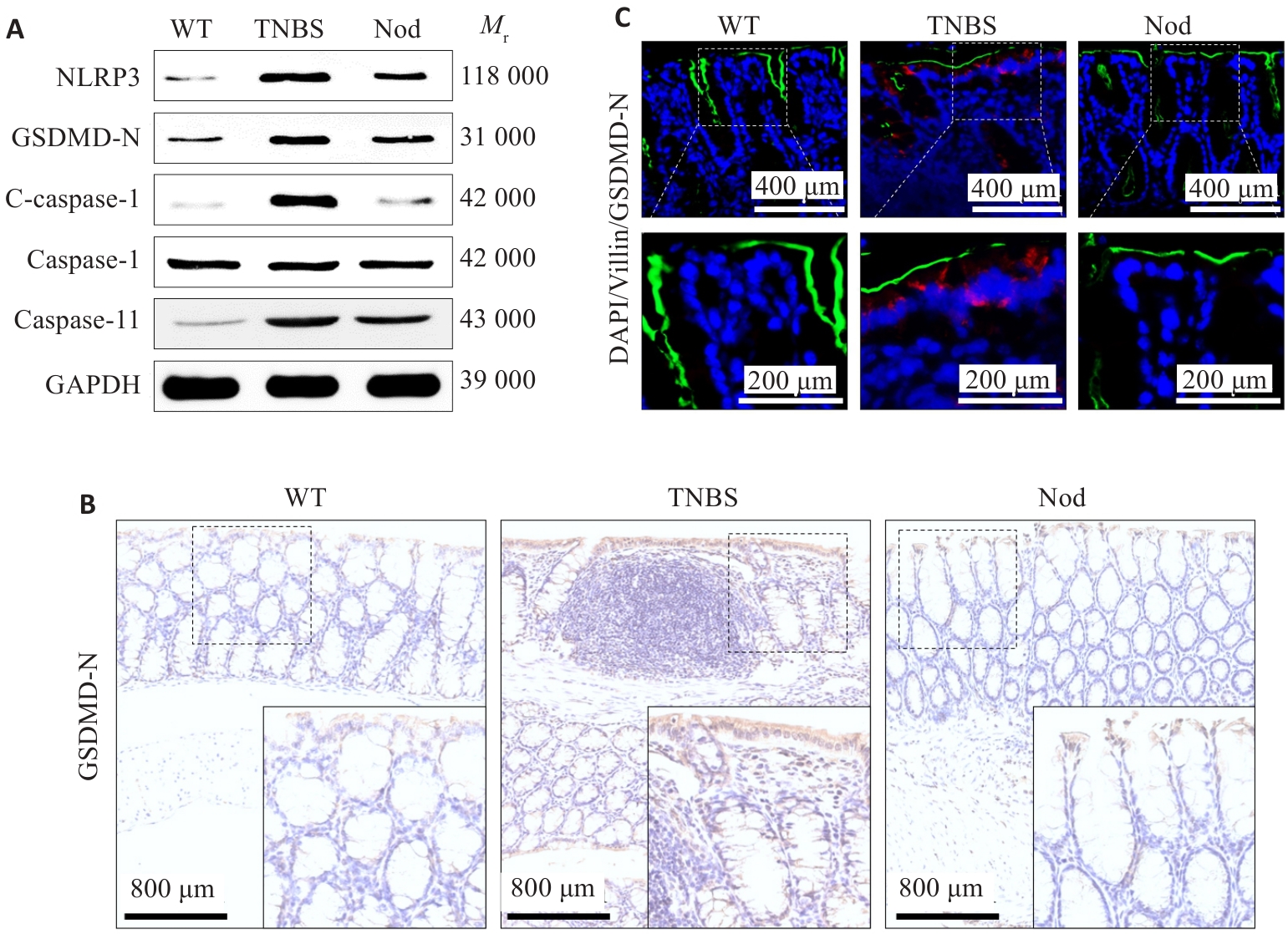
Fig.5 Effect of Nod on epithelial cell pyroptosis in the colon tissue of TNBS-treated mice. A: Western blotting for detecting NLRP3, GSDMD-N, cleaved caspase-1, caspase-1 and caspase-11 levels. B: Expression of GSDMD-N analyzed by immunohistochemical staining. C: Immunofluorescence co-staining of GSDMD-N and Villin.

Fig.6 Effect of Nod on epithelial cell pyroptosis in the colon tissue of TNBS-treated mice and bioinformatics analysis. A: Intersection targets predicted by network pharmacology analysis. B: KEGG enrichment analysis. C: Western blotting analysis of p-PI3K and p-Akt expression levels.
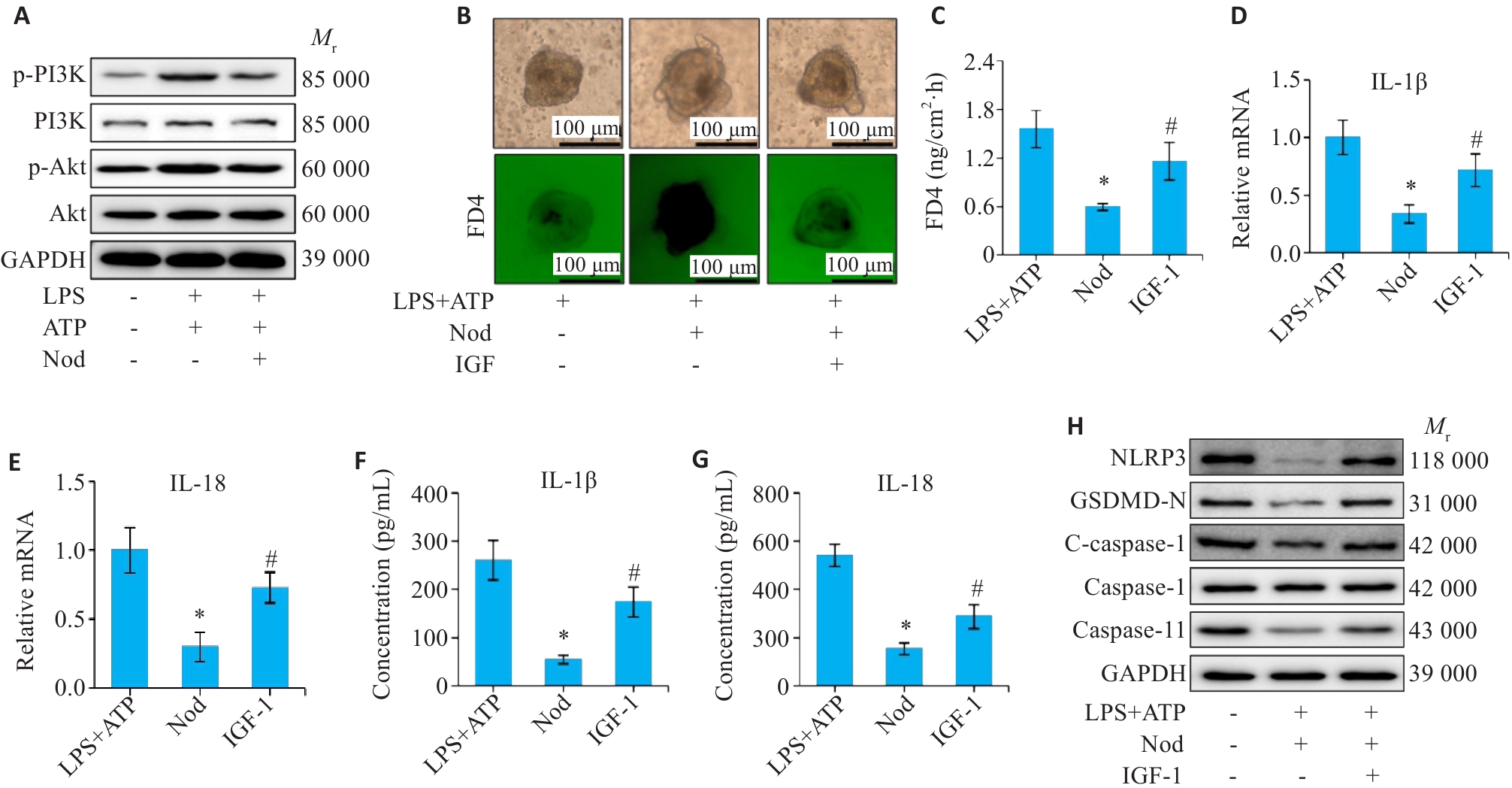
Fig.7 PI3K/Akt is involved in Nod-mediated regulation of colon organoid permeability and expression of pro-inflammatory factors. A: Expression levels of p-PI3K and p-Akt analyzed by Western blotting. B, C: Colonic organoid permeability test. D, E: mRNA levels of IL-1β and IL-18 detected by qRT-PCR. F, G: ELISA for determining IL-1β and IL-18 protein levels. H: Western blotting for detecting NLRP3, GSDMD-N, cleaved caspase-1, caspase-1, and caspase-11 levels. *P<0.05 vs LPS+ATP group; #P<0.05 vs Nod group.
| 1 | Palmela C, Chevarin C, Xu Z, et al. Adherent-invasive Escherichia coli in inflammatory bowel disease[J]. Gut, 2018, 67(3): 574-87. |
| 2 | Cosnes J, Gower-Rousseau C, Seksik P, et al. Epidemiology and natural history of inflammatory bowel diseases[J]. Gastroenterol, 2011, 140(6): 1785-94. |
| 3 | Tan G, Huang CY, Chen JY, et al. Gasdermin-E-mediated pyroptosis participates in the pathogenesis of Crohn's disease by promoting intestinal inflammation[J]. Cell Rep, 2021, 35(11): 109265. |
| 4 | Broz P, Pelegrín P, Shao F. The gasdermins, a protein family executing cell death and inflammation[J]. Nat Rev Immunol, 2020, 20: 143-57. |
| 5 | Cookson BT, Brennan MA. Pro-inflammatory programmed cell death[J]. Trends Microbiol, 2001, 9(3): 113-4. |
| 6 | Shao M, Yan Y, Zhu F, et al. Artemisinin analog SM934 alleviates epithelial barrier dysfunction via inhibiting apoptosis and caspase-1-mediated pyroptosis in experimental colitis[J]. Front Pharmacol, 2022, 13: 849014. |
| 7 | Kim HM, Kim YM. HMGB1: LPS delivery vehicle for caspase-11-mediated pyroptosis[J]. Immunity, 2018, 49(4): 582-4. |
| 8 | Liu W, Chen Y, Meng J, et al. Ablation of caspase-1 protects against TBI-induced pyroptosis in vitro and in vivo [J]. J Neuroinflammation, 2018, 15(1): 48. |
| 9 | Lauro A, D'Amico F, Gondolesi G. The current therapeutic options for Crohn's disease: from medical therapy to intestinal transplan-tation[J]. Expert Rev Gastroenterol Hepatol, 2017, 11(12): 1105-17. |
| 10 | Guo BJ, Bian ZX, Qiu HC, et al. Biological and clinical implications of herbal medicine and natural products for the treatment of inflammatory bowel disease[J]. Ann N Y Acad Sci, 2017, 1401(1): 37-48. |
| 11 | Kang JH, Choi S, Jang JE, et al. Wasabia Japonica is a potential functional food to prevent colitis via inhibiting the NF-κB signaling pathway[J]. Food Funct, 2017, 8(8): 2865-74. |
| 12 | Khare T, Palakurthi SS, Shah BM, et al. Natural product-based nanomedicine in treatment of inflammatory bowel disease[J]. Int J Mol Sci, 2020, 21(11): E3956. |
| 13 | Xu P, Elizalde M, Masclee A, et al. Corticosteroid enhances epithelial barrier function in intestinal organoids derived from patients with Crohn's disease[J]. J Mol Med, 2021, 99(6): 805-15. |
| 14 | Zhang X, Zuo L, Geng Z, et al. Vindoline ameliorates intestinal barrier damage in Crohn's disease mice through MAPK signaling pathway[J]. FASEB J, 2022, 36(11): e22589. |
| 15 | Kim DH, Kim DY, Kim YC, et al. Nodakenin, a coumarin compound, ameliorates scopolamine-induced memory disruption in mice[J]. Life Sci, 2007, 80(21): 1944-50. |
| 16 | Liao Y, Lin X, Li J, et al. Nodakenin alleviates renal ischaemia-reperfusion injury via inhibiting reactive oxygen species-induced NLRP3 inflammasome activation[J]. Nephrology: Carlton, 2021, 26(1): 78-87. |
| 17 | Jia YF, Cui RX, Wang C, et al. Metformin protects against intestinal ischemia-reperfusion injury and cell pyroptosis via TXNIP-NLRP3-GSDMD pathway[J]. Redox Biol, 2020, 32: 101534. |
| 18 | Karmakar M, Minns M, Greenberg EN, et al. N-GSDMD trafficking to neutrophil organelles facilitates IL-1β release independently of plasma membrane pores and pyroptosis[J]. Nat Commun, 2020, 11: 2212. |
| 19 | Li S, Sun Y, Song M, et al. NLRP3/caspase-1/GSDMD-mediated pyroptosis exerts a crucial role in astrocyte pathological injury in mouse model of depression[J]. JCI Insight, 2021, 6(23): e146852. |
| 20 | Wang C, Yang T, Xiao J, et al. NLRP3 inflammasome activation triggers gasdermin D-independent inflammation[J]. Sci Immunol, 2021, 6(64): eabj3859. |
| 21 | Lukonin I, Serra D, Challet Meylan L, et al. Phenotypic landscape of intestinal organoid regeneration[J]. Nature, 2020, 586: 275-80. |
| 22 | Sato T, Vries RG, Snippert HJ, et al. Single Lgr5 stem cells build crypt-villus structures in vitro without a mesenchymal niche[J]. Nature, 2009, 459: 262-5. |
| 23 | Chen XL, Liu GL, Yuan YY, et al. NEK7 interacts with NLRP3 to modulate the pyroptosis in inflammatory bowel disease via NF‑κB signaling[J]. Cell Death Dis, 2019, 10: 906. |
| 24 | Rong L, Li ZD, Leng X, et al. Salidroside induces apoptosis and protective autophagy in human gastric cancer AGS cells through the PI3K/Akt/mTOR pathway[J]. Biomed Pharmacother, 2020, 122: 109726. |
| 25 | Zuo L, Li J, Zhang X, et al. Aberrant mesenteric adipose extracellular matrix remodelling is involved in adipocyte dysfunction in Crohn's disease: the role of TLR-4-mediated macrophages[J]. J Crohns Colitis, 2022, 16(11): 1762-76. |
| 26 | Lim JY, Lee JH, Yun DH, et al. Inhibitory effects of nodakenin on inflammation and cell death in lipopolysaccharide-induced liver injury mice[J]. Phytomedicine, 2021, 81: 153411. |
| 27 | Zuo LG, Li Y, Wang HG, et al. Cigarette smoking is associated with intestinal barrier dysfunction in the small intestine but not in the large intestine of mice[J]. J Crohns Colitis, 2014, 8(12): 1710-22. |
| 28 | Dolinger M, Torres J, Vermeire S. Crohn's disease[J]. Lancet, 2024, 403(10432): 1177-91. |
| 29 | Fantuzzi G, Reed DA, Dinarello CA. IL-12-induced IFN-gamma is dependent on caspase-1 processing of the IL-18 precursor[J]. J Clin Invest, 1999, 104(6): 761-7. |
| 30 | Qu Y, Franchi L, Nunez G, et al. Nonclassical IL-1 beta secretion stimulated by P2X7 receptors is dependent on inflammasome activation and correlated with exosome release in murine macrophages[J]. J Immunol, 2007, 179(3): 1913-25. |
| 31 | Fink SL, Cookson BT. Pillars article: caspase-1-dependent pore formation during pyroptosis leads to osmotic Lysis of infected host macrophages. Cell microbiol. 2006.8: 1812-1825[J]. J Immunol, 2019, 202(7): 1913-26. |
| 32 | Liu ZJ, Gan L, Xu YT, et al. Melatonin alleviates inflammasome-induced pyroptosis through inhibiting NF‑κB/GSDMD signal in mice adipose tissue[J]. J Pineal Res, 2017, 63(1): e12414. |
| 33 | Teshima CW, Dieleman LA, Meddings JB. Abnormal intestinal permeability in Crohn's disease pathogenesis[J]. Ann N Y Acad Sci, 2012, 1258(1): 159-65. |
| 34 | Liu BH, Tu Y, Ni GX, et al. Total flavones of Abelmoschus manihot ameliorates podocyte pyroptosis and injury in high glucose conditions by targeting METTL3-dependent m6A modification-mediated NLRP3-inflammasome activation and PTEN/PI3K/Akt signaling[J]. Front Pharmacol, 2021, 12: 667644. |
| 35 | Xu S, Wang J, Jiang JY, et al. TLR4 promotes microglial pyroptosis via lncRNA-F630028O10Rik by activating PI3K/AKT pathway after spinal cord injury[J]. Cell Death Dis, 2020, 11: 693. |
| 36 | Xu S, Wang J, Zhong J, et al. CD73 alleviates GSDMD-mediated microglia pyroptosis in spinal cord injury through PI3K/AKT/Foxo1 signaling[J]. Clin Transl Med, 2021, 11(1): e269. |
| 37 | Zhang CY, Lin TJ, Nie GH, et al. Cadmium and molybdenum co-induce pyroptosis via ROS/PTEN/PI3K/AKT axis in duck renal tubular epithelial cells[J]. Environ Pollut, 2021, 272: 116403. |
| 38 | Cario E, Gerken G, Podolsky DK. Toll-like receptor 2 controls mucosal inflammation by regulating epithelial barrier function[J]. Gastroenterology, 2007, 132(4): 1359-74. |
| 39 | Lee G, Goretsky T, Managlia E, et al. Phosphoinositide 3-kinase signaling mediates β-catenin activation in intestinal epithelial stem and progenitor cells in colitis[J]. Gastroenterology, 2010, 139(3): 869-81. e9. |
| 40 | Liao Y, Xu JH, Qin BY, et al. Advanced oxidation protein products impair autophagic flux in macrophage by inducing lysosomal dysfunction via activation of PI3K-Akt-mTOR pathway in Crohn's disease[J]. Free Radic Biol Med, 2021, 172: 33-47. |
| 41 | Lee NY, Chung KS, Jin JS, et al. The inhibitory effect of nodakenin on mast-cell-mediated allergic inflammation via downregulation of NF-κB and caspase-1 activation[J]. J Cell Biochem, 2017, 118(11): 3993-4001. |
| 42 | Rim HK, Cho W, Sung SH, et al. Nodakenin suppresses lipopo-lysaccharide-induced inflammatory responses in macrophage cells by inhibiting tumor necrosis factor receptor-associated factor 6 and nuclear factor-κB pathways and protects mice from lethal endotoxin shock[J]. J Pharmacol Exp Ther, 2012, 342(3): 654-64. |
| 43 | Gao QT, Jeon SJ, Jung HA, et al. Nodakenin enhances cognitive function and adult hippocampal neurogenesis in mice[J]. Neurochem Res, 2015, 40(7): 1438-47. |
| [1] | Haiyi ZHOU, Siyi HE, Ruifang HAN, Yongge GUAN, Lijuan DONG, Yang SONG. Moxibustion promotes endometrial repair in rats with thin endometrium by inhibiting the NLRP3/pyroptosis axis via upregulating miR-223-3p [J]. Journal of Southern Medical University, 2025, 45(7): 1380-1388. |
| [2] | Xuan WU, Jiamin FANG, Weiwei HAN, Lin CHEN, Jing SUN, Qili JIN. High PRELID1 expression promotes epithelial-mesenchymal transition in gastric cancer cells and is associated with poor prognosis [J]. Journal of Southern Medical University, 2025, 45(7): 1535-1542. |
| [3] | Fenlan BIAN, Shiyao NI, Peng ZHAO, Maonanxing QI, Bi TANG, Hongju WANG, Pinfang KANG, Jinjun LIU. Asiaticoside alleviates myocardial ischemia-reperfusion injury in rats by inhibiting NLRP3 inflammasome-mediated pyroptosis [J]. Journal of Southern Medical University, 2025, 45(5): 977-985. |
| [4] | Yalei SUN, Meng LUO, Changsheng GUO, Jing GAO, Kaiqi SU, Lidian CHEN, Xiaodong FENG. Amentoflavone alleviates acute lung injury in mice by inhibiting cell pyroptosis [J]. Journal of Southern Medical University, 2025, 45(4): 692-701. |
| [5] | Zhengwang ZHU, Linlin WANG, Jinghan ZHAO, Ruixue MA, Yuchun YU, Qingchun CAI, Bing WANG, Pingsheng ZHU, Mingsan MIAO. Tuihuang Mixture improves α‑naphthylisothiocyanate-induced cholestasis in rats by inhibiting NLRP3 inflammasomes via regulating farnesoid X receptor [J]. Journal of Southern Medical University, 2025, 45(4): 718-724. |
| [6] | Yue CHEN, Linyu XIAO, Lü REN, Xue SONG, Jing LI, Jianguo HU. Monotropein improves motor function of mice with spinal cord injury by inhibiting the PI3K/AKT signaling pathway to suppress neuronal apoptosis [J]. Journal of Southern Medical University, 2025, 45(4): 774-784. |
| [7] | Fei CHU, Xiaohua CHEN, Bowen SONG, Jingjing YANG, Lugen ZUO. Moslosooflavone ameliorates dextran sulfate sodium-induced colitis in mice by suppressing intestinal epithelium apoptosis via inhibiting the PI3K/AKT signaling pathway [J]. Journal of Southern Medical University, 2025, 45(4): 819-828. |
| [8] | Yanyan DONG, Kejing ZHANG, Jun CHU, Quangen CHU. Didang Decoction-medicated serum enhances autophagy in high glucose-induced rat glomerular endothelial cells via the PI3K/Akt/mTOR signaling pathway [J]. Journal of Southern Medical University, 2025, 45(3): 461-469. |
| [9] | Haonan¹ XU, Fang³ ZHANG, Yuying² HUANG, Qisheng⁴ YAO, Yueqin⁴ GUAN, Hao CHEN. Thesium chinense Turcz. alleviates antibiotic-associated diarrhea in mice by modulating gut microbiota structure and regulating the EGFR/PI3K/Akt signaling pathway [J]. Journal of Southern Medical University, 2025, 45(2): 285-295. |
| [10] | Yuejiao PEI, Huimin LIU, Yu XIN, Bo LIU. High expression of miR-124 improves cognitive function of sleep-deprived rats by modulating the PI3K/AKT signaling pathway [J]. Journal of Southern Medical University, 2025, 45(2): 340-346. |
| [11] | Junping ZHAN, Shuo HUANG, Qingliang MENG, Wei FAN, Huimin GU, Jiakang CUI, Huilian WANG. Buyang Huanwu Decoction reduces mitochondrial autophagy in rheumatoid arthritis synovial fibroblasts in hypoxic culture by inhibiting the BNIP3-PI3K/Akt pathway [J]. Journal of Southern Medical University, 2025, 45(1): 35-42. |
| [12] | Yuru ZHANG, Lei WAN, Haoxiang FANG, Fangze LI, Liwen WANG, Kefei LI, Peiwen YAN, Hui JIANG. Inhibiting miR-155-5p promotes proliferation of human submandibular gland epithelial cells in primary Sjogren's syndrome by negatively regulating the PI3K/AKT signaling pathway via PIK3R1 [J]. Journal of Southern Medical University, 2025, 45(1): 65-71. |
| [13] | Hanjun ZUO, Zhaoda DUAN, Zhao WANG, Tao GUO, Jinsha SHI, Haolong SHI, Juanjuan LI. Gastrodin improves microglia-mediated inflammatory response after hypoxic-ischemic brain damage in neonatal rats via PI3K/AKT pathway [J]. Journal of Southern Medical University, 2024, 44(9): 1712-1719. |
| [14] | Xueli ZHOU, Hua LI, Qingyu CHEN, Meina JIN, Haibo LI, Wei BAI, Chuxuan JIA, Cuiying WEI. Effects of chronic intermittent hypoxia and reoxygenation on insulin resistance and skeletal muscle miR-27a-3p/PPARγ/IRS1/PI3K/AKT expressions in rats [J]. Journal of Southern Medical University, 2024, 44(9): 1729-1737. |
| [15] | Xianheng ZHANG, Jian LIU, Qi HAN, Yiming CHEN, Xiang DING, Xiaolu CHEN. Huangqin Qingrechubi Capsule alleviates inflammation and uric acid and lipid metabolism imbalance in rats with gouty arthritis by inhibiting the PTEN/PI3K/AKT signaling pathway [J]. Journal of Southern Medical University, 2024, 44(8): 1450-1458. |
| Viewed | ||||||
|
Full text |
|
|||||
|
Abstract |
|
|||||